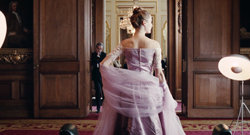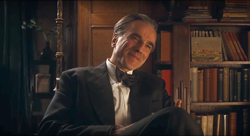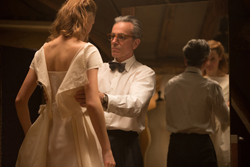I’m notorious for my poor fashion choices. As a Resident Assistant in Laurel Hall, many people rag on me when I mosey around the building in flip flops and ankle socks. After many run-ins with the fashion police, I decided to up my game and wear a pair of Philadelphia Eagles moccasins.
They’re dubbed as, “extra” by the folks I live with, but at least they’re comfortable. Oh, and my mother picked up my first pair of khaki jeans a few months ago, which matches well with my Leonard Cohen embroidered sweater.
Meanwhile, Daniel Day-Lewis’s character, Reynolds Woodcock, in Phantom Thread can be seen in a green checkered blazer with a light green scarf tucked into his dark brown dress shirt just for getting breakfast.
Set in the 1950s, Reynolds Woodcock is a world-renowned fashion designer who creates elegant dresses.
While on a trip to the country, Woodcock becomes interested in a waitress named Alma, played by Vicky Krieps, and takes her into his world of design.
As a meticulous designer Woodcock has an overbearing work method which frustrates Alma, played by Vicky Krieps. However, Alma petrifies the style genius with her own quirks. With their different mannerisms, their relationship isn’t exactly chic.
Surprisingly, Paul Thomas Anderson directs one of his most straightforward films that serves as a fitting end to the incredible career of Daniel Day-Lewis.
 There’s so much tension throughout, with incredible costume design, a strong leading performance by Day-Lewis, and a breathtaking score. But, the ending might rub viewers the wrong way.
There’s so much tension throughout, with incredible costume design, a strong leading performance by Day-Lewis, and a breathtaking score. But, the ending might rub viewers the wrong way.
Recently, director Paul Thomas Anderson has released layered stories that may fly over one’s head.
2014’s Inherent Vice was a complete mess and 2012’s The Master was a strange take on the brainwash of scientology (but in retrospect I like it.) Three years later, Anderson gives a direct story, but takes a chance on the ending.
This leap of faith might divide the audience. For example, as the credits rolled with the graceful orchestral score playing at the theater, one person in a group of elderly ladies yelled, “SO THAT’S IT?”
There was also another lady who sat towards the front with her fingers clasped over her mouth, giving the screen a hard stare while reading the credits all the way down to “catering by.”
Despite Phantom Thread as one of the most accessible pieces in Anderson’s recent filmography, he still finds a way to thread the needle with audiences.
Anderson’s film isn’t dramatic like an episode of Project Runway, but there’s enough tension where one would like to run out of Reynold Woodcock’s sight.
 On his first date with Alma, Woodcock escorts her to his studio where he takes all her measurements, comments on her appearance, quizzes her on what colors would look best, and even his sister shows up to takes notes. If you step into Alma’s dress in that instant, you might yell, “get me out!” However, Alma doesn’t feel beautiful until she’s in Woodcock’s dress.
On his first date with Alma, Woodcock escorts her to his studio where he takes all her measurements, comments on her appearance, quizzes her on what colors would look best, and even his sister shows up to takes notes. If you step into Alma’s dress in that instant, you might yell, “get me out!” However, Alma doesn’t feel beautiful until she’s in Woodcock’s dress.
Imagine wearing Crocs and cargo shorts for years, then a man sweeps you off your Crocs and puts you in a dress that Vanessa Hudgens would be jealous of. It’s an incredible feeling to have restored confidence in yourself, along with Crocs staying off your feet.
It’s not only his beautiful design, but Woodcock’s control is contagious too. In Woodcock’s presence, everything must be exact. Cordial greetings, timeliness, oil instead of butter to cook asparagus, and no tea at midnight are only some of Woodcock’s demands.
Also, Woodcock gives a stare that’ll fill the audience with fear. When someone will ask something of Woodcock, he’ll lower his chin and look up as though he’s waiting for horns to grow on his head. Woodcock’s control and looks creates an environment filled with tension.
Woodcock’s dresses are immaculate with seamless design and are works of art. Costume designer Mark Bridges produced over fifty dresses for the film.
From social events to weddings, Bridges provides an arsenal of variety to capture the atmosphere through costumes. Even Randy Fenoli wouldn’t mind picking up a few gowns for some episodes of Say Yes to the Dress.
The eloquent dress design perfectly matches the cordialness of Phantom Thread’s score by Jonny Greenwood.
When the score played through the booming speakers, I felt guilty wearing my Levi jeans and green button sweater. I wanted to rush out and change into a tuxedo with a top hat and monocle. The score consists of a sixty-piece orchestra playing lush melodies.
It’s no surprise the Daniel Day-Lewis gives an excellent performance as Reynolds Woodcock.
Day-Lewis doesn’t take his role over the top like other characters he’s played such as Abraham Lincoln in Lincoln or Daniel Plainview in There Will Be Blood.
Instead, Day-Lewis plays his character assertively, but not fashionably dramatic. Considering the three-time Oscar winner is supposedly retiring after this film, it’s a nice stitch to the incredible career he’s woven.
When I came back from the theater, I slipped on my Philadelphia Eagles moccasins, sweatpants and a Hanes white tee. Reynolds Woodcock wouldn’t be caught dead in such a pitiful outfit, but the designer’s story is an intense drama filled with technical achievements from costume design to the score.
Above all, I took an important lesson away from Phantom Thread: don’t wear flip flops and socks.
IMAGES TAKEN from FoxMovies



